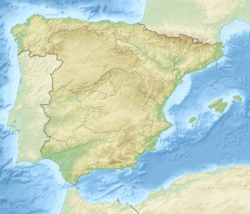Azaila
| Azaila, Aragón, Spain | |||
|---|---|---|---|
| municipality | |||
|
|||
| Coordinates: 41°17′N 0°29′W / 41.283°N 0.483°WCoordinates: 41°17′N 0°29′W / 41.283°N 0.483°W | |||
| Country | Spain | ||
| Autonomous community | Aragon | ||
| Province | Teruel | ||
| Municipality | Azaila | ||
| Government | |||
| • Mayor | Adolfo Tesán Bielsa (PSOE de Aragón) (2015–2019) |
||
| Area | |||
| • Total | 81.44 km2 (31.44 sq mi) | ||
| Population (2015) | |||
| • Total | 116 | ||
| Demonym(s) | Azalaino | ||
| Time zone | CET (UTC+1) | ||
| • Summer (DST) | CEST (UTC+2) | ||
Azaila is a municipality of Teruel province in the autonomous community of Aragon, Spain. It covers an area of 81.44 km² and in 2015 had a population of 116 inhabitants (INE).
Near Azaila lie the ruins of the ancient Iberian village of Cabezo de Alcalá.
The village of Azaila lies on the right bank of the River Aguasvivas, in the Bajo Martín region.
The name (shown as Zaylla in medieval texts) derives from Arabic and means "the flat".
The first settlements were in the village of Cabezo de Alcalá, by the River Aguasvivas, towards Vinaceite, where many different archaeological excavations have provided the stratigraphy of three successive occupations in the village. The first settlers came from central Europe (between the 7th century BC and 218 BC), followed by the Iberians and then the Romans, in the period running from 218 BC to 72 BC, before its final occupation, over the previous remains. It was destroyed between 76 and 72 BC during the Sertorian battles, although other studies have suggested a later date (49 BC), after the battle of Ilerda.
Recently, a medieval Christian necropolis was discovered in the outskirts of the community, near to the ruins of a small medieval fort. It has been dated to some time between the 8th and 16th centuries.
Apart from its name, which is a reference to the plain that extends to the south-east, very little is known about the Muslim settlement.
After the Aragonese occupation at the end of the 12th century, the land was bestowed to aristocrats. In 1196, King Pedro II gave Azaila to Gastón de Castellote, who, together with his family, continued to own the land in 1283.
The names of Romana and Azaila were established in 1215 and 1285 from two of the many terms used during the 8th century. At the end of the 14th century, Azaila was owned by Gastón de Rueda and in the beginning of the 17th century, in 1610, by Pedro de Lanuza.
From a political and administrative point of view, Azaila was included in the Sobrecullida of Zaragoza (1488-1495), Vereda of Zaragoza (1646) and Corregimiento of Alcañiz (1711-1833), mentioned as a village in 1495 and 1785, with its own council, probably from 1834. It was run by the district of Híjar, later to be incorporated in 1965 to the district of Alcañiz. In the new regional organisation, established by the Diputación General de Aragón (the Aragonese government), it is included in the Bajo Martín region.
...
Wikipedia



